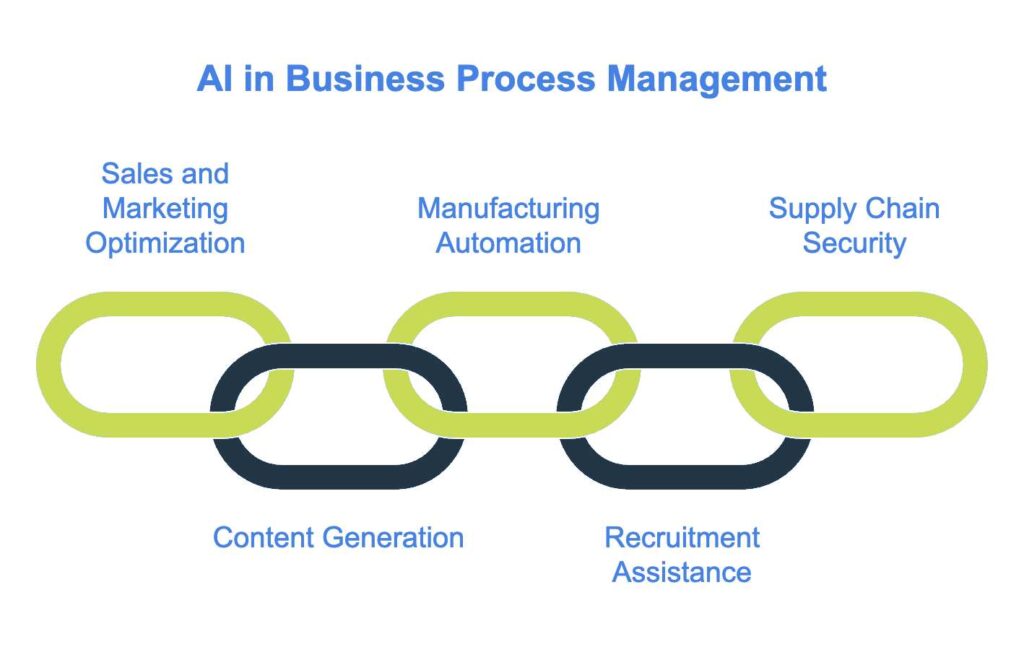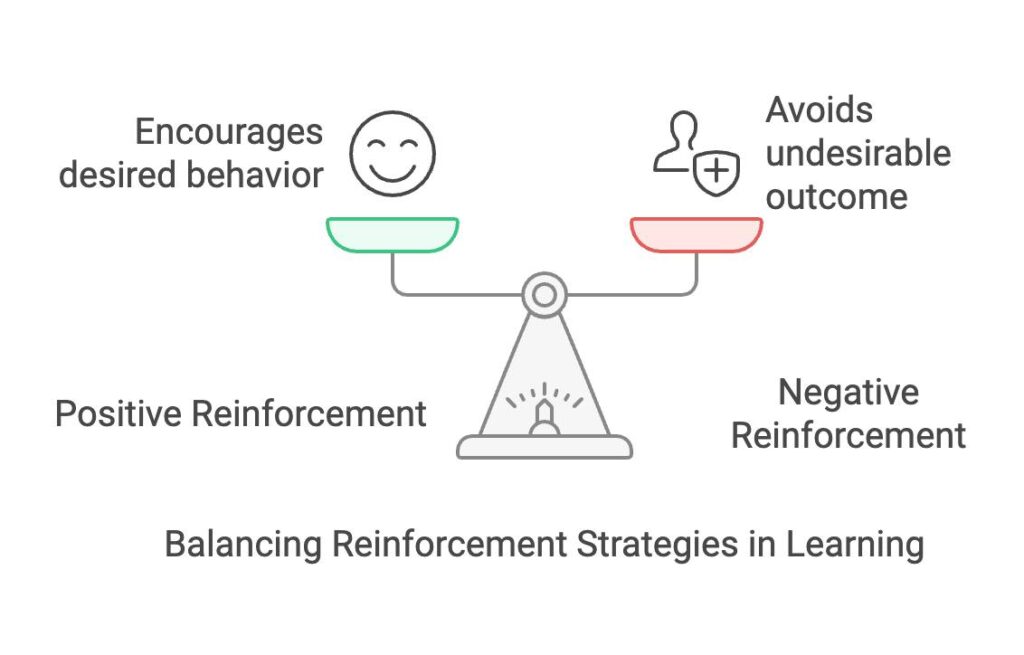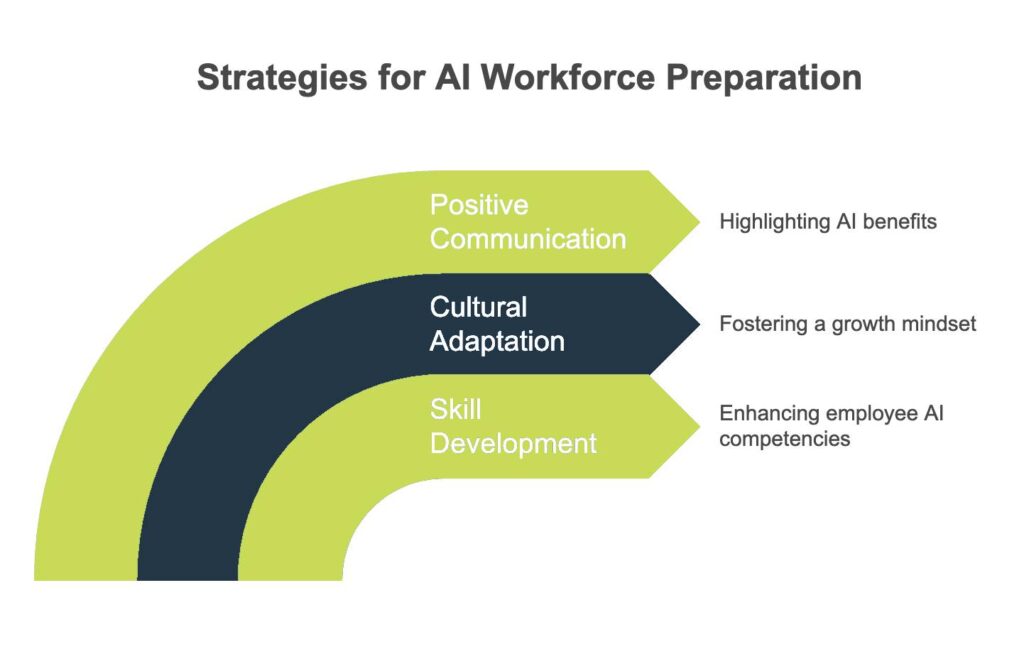The Modern Think Tank: Leveraging AI For Organizational Growth And Innovation
The impact of artificial intelligence in the workplace has been subtle yet profound. The emergence of AI tools has not only increased the rate of innovation but has also helped make employees more productive and established a foundation for economic growth.
Artificial intelligence (AI) and machine learning (ML) are quickly revolutionizing the modern business landscape. According to a Market Analysis Report[1] published by Grand View Research, AI is anticipated to grow at an average annual rate of 37.3 % from 2023 to 2030.
Organizations across nearly all industries are starting to embrace artificial intelligence software and technologies, and many with great success. With its capacity to automate complex tasks and simulate human intelligence, AI has the power to help businesses achieve unprecedented growth and innovation.
01
Chapter 01
The Unseen Impact of AI on Modern Business
AI-powered systems have been increasingly present in the world over the last several years, with newer use cases such as DALL-E 2 and ChatGPT making headlines nearly every day. These innovative technologies are expected to alter the way that businesses operate by optimizing a wide range of processes.
AI is positively influencing nearly all sectors of business, from healthcare and transport to manufacturing and education. A Harvard Business Review[2] study revealed that companies that incorporated AI into their sales and marketing strategies saw a reduction in their call times of between 60 and 70%, an increase in lead generation of over 50%, and an overall reduction of between 40 and 60% in costs.
The AI Effect: A Silent Transformation
The impact of artificial intelligence in the workplace has been subtle yet profound. The emergence of AI tools has not only increased the rate of innovation but has also helped make employees more productive and established a foundation for economic growth.
As more businesses implement artificial intelligence software and tools into their day-to-day operations, this transformation will become more evident. AI has the power to reshape workflows and business models, and with AI’s broad range of applications, businesses will likely see a direct impact on activities, occupations and workers.
Understanding AI Technologies
Artificial intelligence is a broad branch of computer science that focuses on building smart machines that are capable of performing tasks that would usually require human intelligence. Machine learning for natural language processing (NLP) involves the use of ML algorithms and “narrow” AI to understand the meaning of text documents.
Understanding these complex AI technologies can help business leaders better recognize the remarkable capabilities of AI in business
Machine Learning: The Driving Force Behind AI
There are several types of AI, with one of the most common being machine learning. Machine learning enables software applications to become more effective at predicting outcomes without having to be explicitly programmed to perform this task. This is achieved with machine learning algorithms that use historical data as input to accurately predict new output values.
There are several different approaches to machine learning, including the following:
- Supervised learning: Data scientists provide algorithms with labeled training data and specify both the input and output of the algorithm.
- Unsupervised learning: This type of ML involves algorithms that train on unlabeled data and scan through various data sets to look for meaningful connections.
- Semi-supervised learning: Involves a combination of supervised and unsupervised learning but the model is ultimately free to explore data on its own.
- Reinforcement learning: This approach is typically used to teach a machine to complete multi-step processes for which there are defined rules.
Natural Language Processing: Connecting Machines and Humans
Natural language processing is a form of machine learning technology that enables computers to interpret, comprehend and manipulate human language accurately. NLP is now being used to analyze text and speech data effectively. Modern businesses use it for a wide range of automated tasks, such as:
- Processing, analyzing and archiving documents
- Running chatbots for customer service purposes
- Analyzing customer feedback
- Organizing and extracting text
- Answering questions that start with who, when, what and where
The Role of AI in Decision-Making Processes
Artificial intelligence doubles as a powerful decision-making tool that can deliver business leaders with important information that provides a competitive advantage and creates new opportunities for growth and innovation.
AI is capable of processing vast amounts of data that can be used to generate valuable insights that empower organizations to make informed decisions that are backed by data, resulting in enhanced strategic planning and operational efficiency.
02
Chapter 02
Separating Facts from Fiction in AI
With the rapid emergence of AI in business, many misconceptions have developed that have made it difficult to determine fact from fiction. It is important to understand that AI does not serve as a replacement for humans but rather as a tool that augments human capabilities.
Artificial intelligence has the power to foster a harmonious and highly productive business environment. However, businesses must first recognize that AI is merely another tool that they can add to their ever-growing toolkit, one that supports organizational growth and innovation.
Debunking Common AI Myths
From smartphones and computers to a myriad of IoT devices, artificial intelligence is everywhere. Unfortunately, myths have developed over the years that make it difficult to determine what AI can and cannot really do.
One of the biggest AI myths is that machines will ultimately replace humans in the workplace. In fact, a quarter of employees (24 percent) are worried that AI will make their jobs obsolete, according to a recent SurveyMonkey[3] workforce survey. While AI is likely to automate simple tasks, humans will always be needed to fill in-demand skill gaps created by AI.
Another common myth is that artificial intelligence will eventually take over the world. Although AI possesses many strengths, such as accuracy and efficiency, it will never reach a human’s level of emotion and intuition. AI is susceptible to failure, such as in the case reported by The New York Times[4] of a pedestrian dying after being hit by an autopilot Uber vehicle.
Recognizing AI’s Capabilities and Limitations
While the impressive feats of AI cannot be understated, it is also important to recognize where artificial intelligence falls short. AI technologies require ample time and resources. They also operate using the latest software and hardware, making them quite costly to maintain.
In addition, AI lacks ethics and morality, as these are human features that cannot be easily integrated into artificial intelligence software. Improvements can also be difficult to achieve with AI as these machines are designed to complete tasks using pre-loaded information.
Of course, the capabilities of AI are limitless. Artificial intelligence can result in a reduction in human error, round-the-clock availability and new innovations. As machines are not as driven by emotions as humans are, they are also capable of making unbiased decisions.
Understanding AI Bias and Fairness
Artificial intelligence is capable of delivering incredible business value to organizations. In fact, Forrester[5] predicts that nearly 100% of businesses will be using AI by 2025 and that the AI software market is likely to reach $37 billion in the same timeframe.
However, AI bias can occur when humans select the data that algorithms use and decide how the results of these algorithms will be applied. This means that unconscious biases could easily integrate machine learning models due to a lack of testing. AI systems may then automate and perpetuate biased models.
Creating unbiased AI requires educating data scientists about what responsible AI looks like and promoting transparency with consumers. It is also important to promote fairness in AI to ensure its ethical use.
AI Transparency and Explainability
The need for AI systems that are transparent in their operations has long been recognized. Similar to traditional forms of automation, issues such as organizational transparency, data transparency, process transparency and decision transparency will also be important in future AI systems.
Transparency and explainability are two important aspects of AI systems that are critical for building trust. Transparency offers a real-time understanding of an AI system’s actions as part of situation awareness (SA). Explainability delivers information in a backward manner on the process, logic, reasoning and factors upon which the AI system’s actions are based.
While the benefits of transparency are undisputed, there are some key challenges to consider. More research is required in several areas, including the value of different types of transparency information, the best methods for providing system transparency to system operators and the best time to provide AI system transparency information for various classes of operations.
AI as an Innovation Catalyst: Charting New Courses of Business Growth
Nearly every aspect of a business is being transformed by artificial intelligence. This highly diverse tool has enabled business leaders to reconsider how we analyze data, integrate information and leverage the resulting insights to improve decision-making.
From small startups to large enterprises, AI has the power to create breakthrough solutions that drive company growth. Amazon is a perfect example of how AI is building business value. According to McKinsey & Company[6], Amazon’s recommendation engine, which uses IT to predict the most in-demand products to deliver customized recommendations, drives 35% of the retailer’s total sales.
How AI Facilitates Innovative Solutions
AI is accelerating innovation at a rapid rate. These innovative solutions enable businesses to tackle complex problems, enhance customer experiences and streamline operations.
While nearly every industry is benefiting from the impact of AI, the healthcare sector has seen some of the biggest changes. According to Goldman Sachs[7], AI has released technologies that have the potential to be transformative in healthcare, such as cloud computing, deep learning, blockchain and big data analytics.
Implementing AI for Business Process Innovation
When business leaders combine their unique skills with the processing power of AI algorithms, they can enjoy a wealth of company benefits, such as improved efficiency, increased competitiveness and enhanced decision-making. With AI, businesses can promote greater productivity and growth by automating routine tasks, gaining actionable insights and developing more efficient processes.
The Role of AI in Business Process Management
AI is applicable in nearly any scenario, meaning there are many ways in which this technology can optimize business processes. By automating tasks and generating data-backed insights, artificial intelligence can reduce errors, streamline processes and improve operational efficiency.
Businesses can use AI to:
- Optimize sales and marketing
- Generate engaging and informative content
- Enhance automation and robotics in manufacturing
- Aid in employee recruitment
- Improve security across the supply chain

Personalization and Predictive Insights: AI in Customer Engagement
Many businesses underestimate the importance of good customer service. According to a Salesforce[8] report, 84% of customers reveal that the experience a business provides is as important as its products and services.
AI’s ability to deliver predictive insights and personalized content can help revolutionize customer engagement. Businesses can now leverage these capabilities to foster loyalty and enhance customer service.
The Competitive Edge: AI as a Strategic Tool for Business Growth
Modern businesses are always on the lookout for new ways to gain a competitive advantage. With AI’s ability to automate operations, optimize business models, and innovate products and services, businesses can achieve expedited growth.
Artificial intelligence has the power to create sustainable business growth. Turkish-based cement manufacturing company OYAK Cimento[9] is the perfect example. The company implemented AI technology to reduce its carbon emissions, resulting in an elimination of 200,000t of CO2 emissions in 2021.
Optimizing Business Models with AI
AI’s ability to build or optimize business models is causing fundamental shifts in nearly all industries. The newest forms of artificial intelligence are capable of analyzing vast amounts of data and generating valuable insights that help companies identify growth opportunities, reveal inefficiencies and make more strategic decisions.
As AI continues to reshape business models, companies can expect:
- Enhanced data analytics
- Intelligent automation
- Personalized customer experiences
- Improved cybersecurity
- Better supply chain management
- Advanced decision-making
AI-Enabled Product and Service Innovations
Artificial intelligence is enabling businesses to learn more about how their consumers are using their products and services. When companies fail to integrate AI into their products and services, they could miss out on opportunities for brand loyalty and business growth. Many organizations are now developing AI pilot programs that are aligned to strategic big bets.
Personalized recommendations, intelligent automation and predictive maintenance are just some of the powerful features that AI is bringing to modern businesses. By leveraging these tools, companies can drive customer value, foster business growth and develop differentiated offerings.
03
Chapter 03
Behind the Scenes: Understanding the Science that Drives AI
Using AI to make informed decisions about AI initiatives requires business leaders to have a solid understanding of the science that drives artificial intelligence. The five core technologies of AI include:
- Computer vision: This is the computer’s ability to recognize scenes, objects and activities from images using a sequence of image processing operations and similar technologies.
- Machine learning: This is the ability of a computer system not to follow a program’s explicit instructions but to instead use data to improve performance.
- Natural language processing: This refers to the human-like processing capabilities of computers and combines multiple technologies to achieve goals.
- Robot: Integrating cognitive abilities, such as automatic planning and machine vision, has resulted in a new generation of robots.
- Speech recognition: This technology involves the transcription of human speech accurately and automatically.
The Building Blocks of AI: Algorithms and Data
Algorithms and data are considered the fundamental building blocks of artificial intelligence. AI algorithms refer to the set of rules or instructions that enable machines to analyze data, learn and make decisions based on gathered knowledge.
These powerful algorithms can perform a wide range of tasks that would normally require human intelligence, such as understanding natural language, recognizing patterns, decision-making and problem-solving. The three main techniques used in AI algorithms include machine learning, deep learning and natural language processing.
Emerging AI Technologies and Techniques
New AI technologies are evolving at a rapid rate and have the potential to impact the future of modern businesses significantly. From chatbots used for prompt customer service to predictive analytics that allow for accurate forecasting, companies across all industries are now enjoying innovative technologies that help improve efficiency, enhance customer experience and reduce costs.
To boost productivity and profitability, it is important for business leaders to keep pace with the newest AI developments. Some of the most promising emerging AI technologies include deep learning and reinforcement learning.
Deep Learning
Deep learning is a subset of machine learning inspired by the structure of the human brain. This neural network has three or more layers and attempts to simulate human-like behavior, allowing it to essentially “learn” large amounts of data.
This unique form of technology powers many everyday products and services, such as voice-enabled TV remotes, digital assistants, and credit card fraud detection. It also promoted breakthroughs in fields such as speech and image recognition.
Reinforcement Learning
Reinforcement learning is a specialized area of machine learning that involves taking a suitable action to maximize a reward in a specific scenario. This autonomous, self-teaching system learns by trial and error, with the output dependent on the state of the current input and the following input dependent on the previous input.
There are two main types of reinforcement learning: positive and negative. Positive reinforcement occurs when a particular event has a positive effect on behavior. Negative reinforcement is the strengthening of behavior due to a negative condition being avoided or stopped. The elements of reinforcement learning include:
- Policy
- Reward function
- Value function
- Model of the environment

Discovering Unconventional Applications of AI in Business
AI has typically been associated with customer service bots or predictive analytics. However, its applications in the business realm are expanding in unprecedented directions, offering savvy companies a leg up in their respective industries. Let’s delve into some less-talked-about avenues where AI is making waves:
Market Trend Prediction
Beyond traditional financial analytics, AI scrutinizes social media, news outlets, and even niche forums to predict micro-trends that can balloon into major market shifts. This provides a holistic view of the market’s potential trajectory.
Employee Wellness Checks
Companies are using AI to gauge employee morale and mental health subtly. By analyzing communication patterns, feedback, and even pauses in work, AI can recommend when it might be time for a team-building activity or a wellness day.
Sustainable Decision-Making
AI assists businesses in becoming more eco-friendly. It can analyze a company’s carbon footprint in real-time, suggesting sustainable alternatives for energy consumption, travel, and even suggesting eco-friendly vendors.
Product Development Feedback Loop
Instead of lengthy feedback forms, AI can now analyze real-world usage of products (with user consent) to suggest design or functional improvements. This could range from software applications to physical appliances.
In this ever-evolving landscape, business leaders should remain curious about AI’s potential. By exploring unconventional AI applications, businesses not only gain a competitive edge but also harness the power to revolutionize entire industries.
Uncovering Hidden Opportunities
The power of AI in uncovering hidden opportunities within business landscapes cannot be overstated. Here’s how AI reveals these gems and how businesses can seize them:
- Pattern Detection: AI analyzes massive datasets to uncover subtle patterns, revealing niche markets or unmet customer needs, often overlooked by human analysis.
- Consumer Behavior Prediction: AI’s ability to forecast trends by analyzing purchase histories and online interactions enables businesses to adjust strategies before these trends become mainstream.
- Personalized Experiences: AI fosters customer loyalty and uncovers upselling opportunities by crafting tailored user experiences, from product recommendations to content delivery.
- Internal Efficiency Improvements: Beyond external market opportunities, AI can pinpoint areas within the organization where process enhancements or technology implementations could boost efficiency.
- Risk Forecasting: AI can also advise on potential risks by monitoring global events and market shifts, enabling timely responses.
To harness these opportunities, businesses should focus on:
- Data Integrity: Ensuring accurate and comprehensive data feeds into AI systems.
- Adaptability: Being ready to pivot strategies based on AI insights to capitalize on opportunities.
- Continuous Learning: Staying updated with AI advancements for sustained success in opportunity detection.
Through strategic AI integration, organizations can discover and act on countless hidden opportunities, driving growth and innovation.
Identifying Areas for AI Applications
As the functions of artificial intelligence continue to soar by the day, it makes sense for businesses to integrate these tools into many different areas, from operators to customer service. In fact, by 2025, Servion[10] predicts that three-quarters of customer service interactions will be driven by AI platforms.
Determining where to integrate AI within a business can significantly amplify results. Here’s a concise guide to recognizing those potential zones:
- Operations Optimization: AI can streamline processes, predict equipment maintenance, and optimize supply chains, reducing downtime and costs.
- Enhanced Customer Service: Chatbots and AI-driven support tools offer timely and tailored customer responses, elevating satisfaction levels.
- Sales and Marketing: AI tools can forecast sales trends, segment audiences more effectively, and personalize marketing campaigns, boosting conversions.
- Human Resources: AI can simplify recruitment through candidate matching, and assess employee satisfaction or performance trends.
- Product Development: AI can analyze customer feedback to guide new product features or predict market needs for innovation.
To evaluate the feasibility of AI projects:
- Data Review: Ensure you have consistent and quality data, as AI thrives on robust data sets.
- Cost-Benefit Analysis: Weigh the potential benefits against initial AI setup and maintenance costs.
- Skills Assessment: Determine if in-house expertise is available or if external consultants are required.
By pinpointing these areas and conducting thorough evaluations, businesses can integrate AI seamlessly, driving efficiency and innovation.
Exploring Innovative AI Implementations
Business leaders are able to implement AI to scale their businesses in a way that would be impossible without this technology. With the potential to offer next-level products and services, many companies are integrating AI in innovative ways.
For example, Alibaba, the world’s largest e-commerce platform, uses AI in its day-to-day operations. The Chinese company relies on natural language processing to automatically generate product descriptions, as well as other AI tools to predict what customers may want to purchase.
AI is also growing by leaps and bounds in the healthcare sector. This technology has become prominent in the research and development of new drugs. The newly founded company Healx[11] uses AI drug discovery to develop new treatment options for rare diseases.
AI’s Role in Solving Complex Business Problems
Many businesses look to AI when searching for new ways to solve complex business problems. AI’s computational power and data analysis capabilities can solve intricate problems that traditional methods cannot. For example, businesses that cannot afford to have round-the-clock staff may turn to artificial intelligence to aid their customer service strategy. AI customer support offers 24/7 availability and faster solutions than traditional business models.
Voice and face recognition are other technologies that can solve common business problems. With the use of biometrics, businesses can recognize customers and greet them in a more personalized way. These technologies also allow companies to authenticate customers to help reduce fraud.
04
Chapter 04
AI Integration: Navigating Challenges and Mitigating Risks
While more businesses plan to invest in AI to improve their products and operations, AI deployment comes with certain roadblocks and challenges. From technology challenges of data issues to implementation challenges such as skills shortages, it is important to be aware of these risks and how to prevent them.
Overcoming Obstacles in AI Implementation
Introducing AI into business operations comes with its unique set of challenges. One of the primary issues faced by many organizations is a deficiency in quality data. AI, at its core, relies on vast amounts of reliable data. To combat this, businesses should emphasize regular data collection and work with data experts to refine their datasets.
Another common roadblock is the skills gap. Many companies lack the in-house expertise needed to fully harness AI’s capabilities. Addressing this can involve a blend of training for current employees, hiring specialists, or seeking external collaborations with AI experts.
Resistance to change is also a significant impediment. Employees might be apprehensive about AI integration, fearing it may complicate their roles or even replace them. Open communication about the advantages of AI, coupled with training sessions, can assuage these fears and help in gaining employee buy-in.
Lastly, the initial investment for AI setup and its ongoing costs can be daunting. Budget constraints are a common challenge for modern businesses, especially smaller companies; according to a Harvard Business Review[12] report, 40% of executives report that an obstacle to AI initiatives is that these technologies are too costly. A thorough cost-benefit analysis can offer clarity. Implementing AI in phases, targeting high-impact areas first, can spread out the costs and allow businesses to witness AI’s benefits gradually.
By understanding and proactively addressing these challenges, businesses can position themselves for successful AI integration.
Best Practices for Smooth AI Integration
While integrating AI can be highly advantageous, it is not without challenges. From securing employee buy-in and top management support to adopting an iterative approach and ensuring robust data management, implementing best practices helps businesses maximize the benefits of AI while minimizing obstacles.
For smooth AI integration, consider the following steps:
- Define use cases and objectives
- Assess data readiness
- Conduct technology assessments
- Pilot and test
- Prepare for change management
- Implement and integrate
- Monitor KPIs
- Support ongoing training
Preparing Your Workforce for AI
Businesses do not need to hire externally to successfully adopt AI. Instead, they can train their own employees by helping workers develop AI skills, address fear and resistance, and foster a culture of continuous learning and improvement.
It is important to educate employees about the new technological changes that AI will bring and prepare workers for these changes by encouraging a “growth mindset” that promotes learning and skill development.
Business leaders should also create a positive culture around AI. This can be achieved by communicating how automation and AI can help teams and make the organization more successful.

Ensuring Ethical Use of AI
With the growth of AI, many businesses have developed ethical concerns. From bias to privacy issues, business leaders must ensure that the technology is being used properly to avoid potentially costly repercussions.
One of the biggest ethical concerns related to AI is the potential for automation to eventually displace employees. Although AI can reduce costs and improve efficiency, it can also result in job loss when certain positions, and therefore, workers, are replaced by machines. It is important for businesses to consider the impact that AI could have on the workforce and strategize to mitigate these
The AI-Human Partnership: A Match Made for Business Success
While many remain concerned that artificial intelligence will ultimately take over the world, AI should not be thought of as a competitor but a collaborator. When AI and human intelligence come together, businesses can achieve greater efficiency, innovation and profitability. Fostering an environment that promotes the co-existence of humans and AI can lead to mutual growth.
Humans and AI have different strengths and weaknesses. Humans have empathy, creativity and critical thinking skills, while artificial intelligence technology excels at performing repetitive tasks and processing large amounts of data. By working together, humans and AI can produce remarkable results.
Exploring the Synergy Between AI and Human Intelligence
To achieve seamless collaboration between humans and AI, businesses must strategically consider their approach toward organizational frameworks and business practices. In the same way that AI can amplify human capabilities, human judgment and creativity can help guide AI applications.
To successfully assist machines, humans must perform three critical roles:
- They must properly train machines to perform specific tasks.
- They must explain the outcomes of these tasks, especially when the outcome is controversial or counterintuitive.
- They must promote the responsible use of machines, such as by ensuring that they are safe for use by humans.
Enhancing Human Capabilities with AI
Despite its many incredible feats, AI can never completely replace human intelligence. However, AI can enhance human capabilities. From providing data-driven insights to automating mundane tasks, artificial intelligence can be useful for providing humans with the time to do what they do best: be creative and engage in strategic thinking.
AI can also enhance human capabilities in other ways, such as communication. AI-powered communication tools are transforming the ways that teams collaborate. This technology can also be useful in other areas of business, such as project management and workflow.
The Role of AI in Augmenting Human Creativity
Artificial intelligence opens up new opportunities for humans to focus on innovation in many areas, including creativity. AI enables humans to creatively utilize and combine technologies to develop new and better ways of working. When AI tools take over time-consuming tasks, humans can focus on higher-level creative thinking, adding true value to their organizations.
With AI, businesses can also expand their creative horizons by exploring avenues that they would have otherwise overlooked. For example, AI algorithms can analyze large amounts of data to identify patterns and generate fresh ideas that a person may not have thought of on their own.
Peering into the Future: Anticipating AI’s Evolving Role in Business
The impact of AI on business is already happening across the world. According to HubSpot[13] data, 31% of business leaders revealed that AI and other automation tools are important to their overall business strategy. In addition, 43% say that they plan to increase their investment in AI tools throughout 2023.
While no one knows the future of AI, the possibilities are endless. Artificial intelligence can improve nearly all aspects of business, from automating routine tasks and aiding in decision-making to improving the customer experience and reducing costs by optimizing processes.
One of the best ways that today’s businesses remain competitive in a rapidly evolving technological world is by leveraging the power of AI. At Orases, we offer cutting-edge AI and machine learning services to help organizations thrive in the digital age.
Our Concluding Thoughts: AI’s Transformative Power for Business Evolution
Throughout this guide, the transformative potential of AI in business is evident. However, leveraging AI’s full capabilities requires expertise and understanding. At Orases, we’re committed to guiding businesses on this journey, offering support at every step. From identifying AI opportunities to overcoming implementation challenges, our team ensures seamless integration. As the business landscape evolves, partner with Orases to harness AI’s power for unparalleled growth and innovation. Let’s shape the future, together.



To explore how AI can redefine your business’s potential, reach out to the Orases team today. Give us a call at 301.756.5527 or schedule a consultation with our experts, and let’s begin crafting your tailored AI strategy for growth and innovation.
References
[3] SurveyMonkey
[5] Forrester
[7] Goldman Sachs
[8] Salesforce
[9] OYAK Cimento
[10] Servion
[11] Healx
[13] HubSpot








